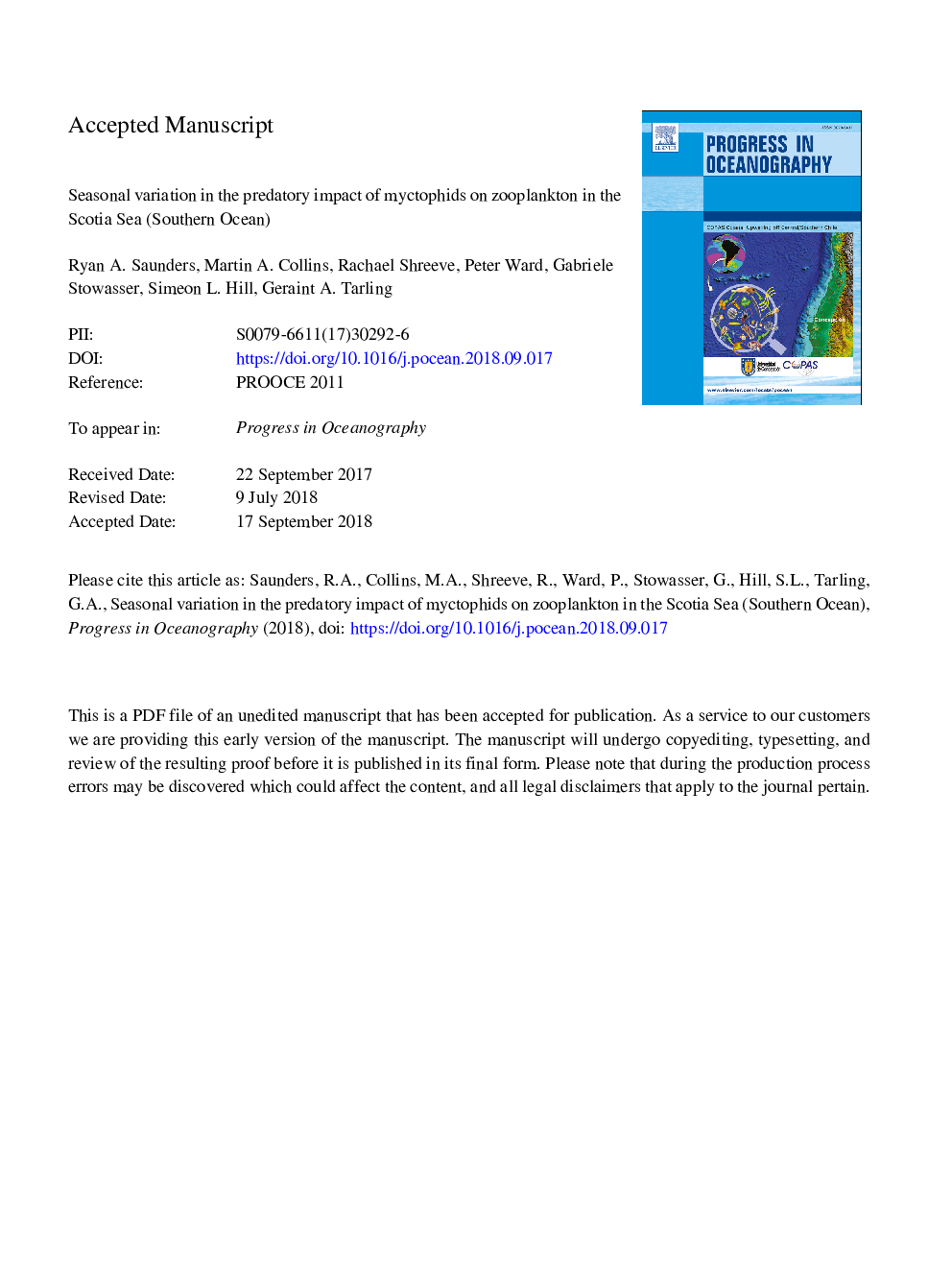| کد مقاله | کد نشریه | سال انتشار | مقاله انگلیسی | نسخه تمام متن |
|---|---|---|---|---|
| 10223945 | 1701065 | 2018 | 59 صفحه PDF | دانلود رایگان |
عنوان انگلیسی مقاله ISI
Seasonal variation in the predatory impact of myctophids on zooplankton in the Scotia Sea (Southern Ocean)
ترجمه فارسی عنوان
تنوع فصلی در اثر غلط گیر متیوفیدی ها در زئوپلانکتون در دریای اسکوشیا (اقیانوس جنوبی)
دانلود مقاله + سفارش ترجمه
دانلود مقاله ISI انگلیسی
رایگان برای ایرانیان
کلمات کلیدی
موضوعات مرتبط
مهندسی و علوم پایه
علوم زمین و سیارات
زمین شناسی
چکیده انگلیسی
Myctophids are the biomass-dominant mesopelagic fishes in the Southern Ocean, but their trophic role within the pelagic food web south of the Antarctic Polar Front is poorly resolved from a seasonal perspective at the ocean-basin scale. In this study, the predatory impact of the predominant Southern Ocean myctophid community (Electrona antarctica, Electrona carlsbergi, Gymnoscopelus braueri, Gymnoscopelus fraseri, Gymnoscopelus nicholsi, Protomyctophum bolini, Protomyctophum tenisoni, Protomyctophum choriodon, Krefftichthys anderssoni and Nannobrachium achirus) on their zooplankton prey was examined during austral spring, summer and autumn in the Scotia Sea, one of the most productive regions of the Southern Ocean. Seasonal variations in diet and predation rates were apparent for all species. Based on the percentage index of relative importance, myctophids had high overlap in their diets, with all species mostly consuming copepods, small euphausiids and amphipods. Myctophid size was a key determinant of diet in the region, with larger species and intra-specific size classes consuming larger prey. Cluster analyses revealed myctophid feeding guilds that appeared to change seasonally, although there was little evidence of dietary specialisation. Myctophid predation on the daily productivity of most copepod species was relatively low across seasons (<7%), except for Calanus simillimus that was predated upon highly in summer (â¼26%). From the macrozooplankton component of the prey field, the myctophid community consumed substantial proportions of the euphausiid Thysanoessa spp. in each season (â¼7 to 76% daily productivity), particularly in summer. Relatively high proportions of the daily Antarctic krill (Euphausia superba) productivity (â¼8-58%) were also consumed by the larger myctophid species, particularly in summer by Electrona antarctica, suggesting increased competition for krill resources during the higher predator breeding season and possible reductions in food web stability during periods of reduced krill availability at this time. The amphipod Themisto gaudichaudii formed an important part of the larger myctophid species' diet in all seasons, with between 10 and 38% of its daily productivity being consumed. Myctophid predation on the daily productivity of salps was up to 4%, whilst their impact on ostracods and pteropods was negligible (<0.1% of daily productivity) in all seasons. This study demonstrates that Southern Ocean myctophids link secondary productivity to higher predators through both krill-independent and krill-dependent trophic pathways across seasons, with myctophids comprising a more krill-dependent pathway during austral summer.
ناشر
Database: Elsevier - ScienceDirect (ساینس دایرکت)
Journal: Progress in Oceanography - Volume 168, November 2018, Pages 123-144
Journal: Progress in Oceanography - Volume 168, November 2018, Pages 123-144
نویسندگان
Ryan A. Saunders, Martin A. Collins, Rachael Shreeve, Peter Ward, Gabriele Stowasser, Simeon L. Hill, Geraint A. Tarling,
